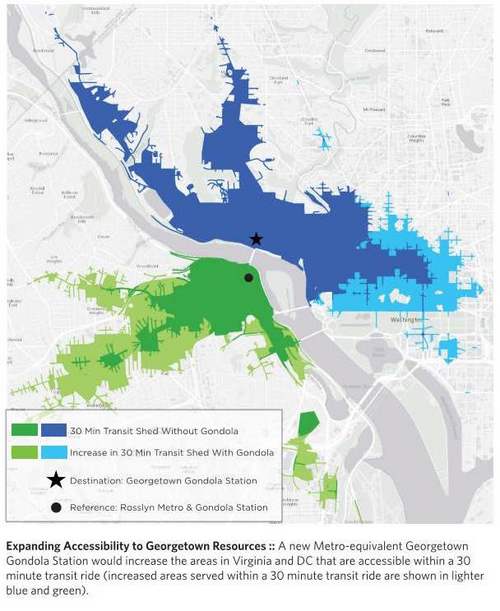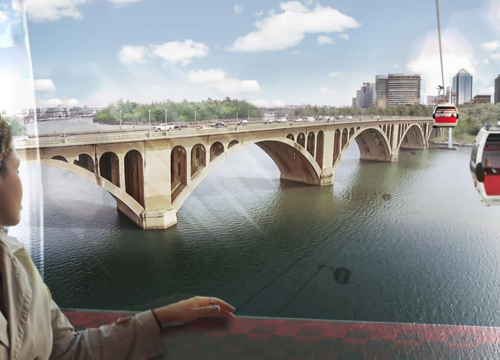Could a gondola from Georgetown to Rosslyn work? A study says yes.
Getting from Georgetown to Rosslyn, or to any Metro station, isn’t easy. An aerial gondola across the Key Bridge could provide the missing connection, say leaders of the two neighborhoods, and a new study looks at how to make it happen, what it will cost, and where stations would go.
The idea for the gondola — cable-operated aerial trams, not the Venetian boats — first came up in 2013, when the Georgetown Business Improvement District (BID) included it in its 15-year action plan. The goal is to fill the public transit gaps between Georgetown and Rosslyn, most notably the lack of a Metro stop.
In May 2015, Greater Greater Washington contributor Topher Mathews wrote that yes, this idea was at least worth looking into. While he said there were valid reasons to be skeptical of a gondola, like it being too expensive, or a distraction from more practical transit options, or just a shiny new toy, he also noted that “we won’t know that for certain without the study.”
Topher went on to note that gondolas are relatively cheap compared to, say, rail, that a quick ride from Georgetown to the Metro would be ideal, and that more bus lanes between Georgetown and Rosslyn really weren’t politically feasible.
In July, both the Georgetown and Rosslyn BIDs, along with DC, Arlington County, Georgetown University and a number of businesses in the neighborhood, and a group of developers began studying the possibility in earnest.
The findings of the study came out today. Here are some of the details:
Where might stations go?
The study considered several station locations on either side of the river. The report said the top preferences are the the Exxon Station/36th Street right-of-way site in Georgetown (just north of M Street, near the “Exorcist steps”) and North Lynn Street adjacent to Central Place in Rosslyn. Putting stations here would not require an angle station to re-direct the cables (in other words, the route would be a straight shot), and it would provide access to both Georgetown University and M Street.
The Exxon site would require private land acquisition (which could be tough given a recent proposal to build condos there). The study says the site would allow easy access to both M Street (below the Exorcist steps) and Prospect Street above, meaning it’d be less than a 10 minute walk from both the retail corridor and the lawn fronting the Georgetown campus.
The other Rosslyn site that’s under serious consideration, Fort Myer Drive, would require an angle station, as would another proposed site in Georgetown, 3401 Water Street (just below the C&O Canal).

In both of these images, the Georgetown station is at the Exxon site. The image on the left shows the Rosslyn station on Fort Myer Drive, and on the right it’s on North Lynn Street.
Proximity to Metro is a huge piece of the puzzle
Connecting to Metro is a critical piece of the entire gondola idea. In fact, Georgetown BID CEO Joe Sternlieb said the “goal is to make this the equivalent of the Georgetown Metro station.”
In Rosslyn, both the North Lynn and Fort Myer sites are half a block and a block from a Metro entrance, meaning it could take as little as two minutes to transfer from the gondola, according to Sternlieb.
The report proposes building a new “vertical connection” between Metro and gondola station for the Fort Myer site, while using the new elevators built as part of the Central Place development to connect Metro to the North Lynn site.
According to the report, the gondola would put a lot more places within a 30-minute transit commute: you could take the gondola and then metro further west along the Rosslyn-Ballston corridor as well as to Pentagon City and Crystal City in Virginia, and you could also go east into the District toward L’Enfant Plaza, Mount Vernon Square, and Penn Quarter. (As counterintuitive as it seems, Georgetown workers and residents could take the gondola to Virginia and then Metro back into the District.)

Here, the dark colors represent the places that are currently within a 30-minute transit ride of Rosslyn and Georgetown. The lighter colors show how a gondola would expand those options.
Federal approval is key
The National Park Service has jurisdiction over the river and the C&O Canal National Historical Park, both of which a gondola would have to cross with a visible set of wires and towers.
Due to the multi-jurisdictional nature of the project and the fact that it would cross federal land, a number of agencies and entities — including the National Capital Planning Commission and the Commission of Fine Arts — would have to approve the project. The consultants conducting the feasibility study did meet with NPS, NCPC, and CFA representatives.
Also, the Federal Aviation Administration has to approve tall buildings that go up in Rosslyn because it’s so close to the flight path into DCA. A real consideration with the gondola cables is that airplane wings can create vortices that might lead to dangerous turbulence.
Costs, projected ridership, and potential economic benefits
At a projected cost of $80-90 million, the gondola would be significantly cheaper than the $1.5 billion for a Georgetown Metro tunnel and station laid out in the Metro 2040 Plan. It’s even cheaper than building a Metro station alone.
The report estimates that between 6,000 and 15,000 people would ride the gondola each day. The project could replace several existing bus routes, cutting nearly 100,000 Georgetown University Transportation Shuttle and DC Circulator bus trips over the Key Bridge per year.
Organizers also see economic development benefits, especially for hotels in Rosslyn — increased occupancy and rates would boost local business and tax revenue — and restaurants and retail on both sides of the Potomac. Rosslyn officials also see the potential for more Georgetown workers to live in Rosslyn, potentially boosting rent and property tax revenue.
The study says that the development community is “generally supportive” and that the gondola could contribute to vitality and “buzz” for both neighborhoods with respect to office, retail, and residential considerations.
Could this happen anytime soon?
The feasibility study is only the latest step in making a gondola happen. Future phases would involve more public input and details on funding, which would involve multiple jurisdictions. The feasibility study found that the approval process could take 3-4 years, with an additional two years for construction.
The Georgetown and Rosslyn BIDs will host a public meeting tonight at the Georgetown Theater (1351 Wisconsin Avenue NW), featuring a presentation of the feasibility study findings and questions from the audience. Doors open at 6 pm. You can find more details here.


